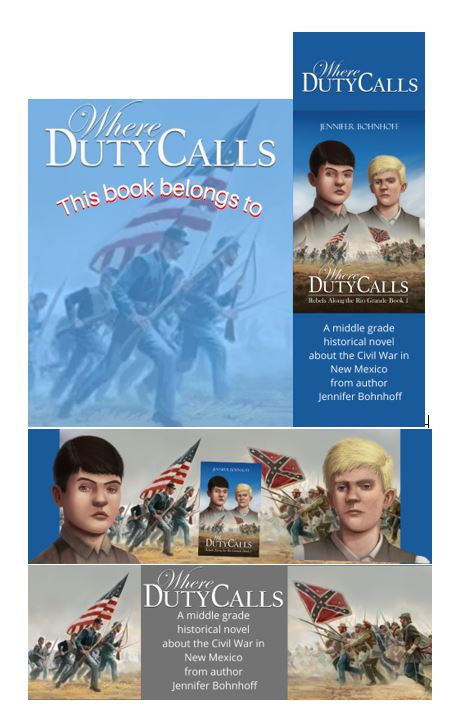Book 1: Where Duty Calls

Two boys from different cultures, one a Texan, one a New Mexican, get caught up on opposite sides of the US Civil War.
Jemmy wants to get his mules home safely to Texas. Raul wants all the Americanos, both Union and Confederate, out of New Mexico. Neither want war, but will meet at the Battle of Valverde.
Published by Kinkajou Press, a division of Artemesia Publishing.
Jemmy wants to get his mules home safely to Texas. Raul wants all the Americanos, both Union and Confederate, out of New Mexico. Neither want war, but will meet at the Battle of Valverde.
Published by Kinkajou Press, a division of Artemesia Publishing.
Book 2: The Worst Enemy

Civil War action and drama for young readers that will appeal to young readers, parents, and teachers.
Two boys. One battle. A life-changing encounter. Jemmy Martin left his Texas farm and followed Confederate General Sibley's Army into New Mexico to keep his mules safe. Now he's protecting Willie, an orphaned drummer boy with a broken arm. Cian Lochlann is an Irish orphan who gave up gold prospecting to join the Union Army. All he wants is a full belly and a strong man to lead him into an unknown future. The three meet when the Confederate and Union Armies clash in the mountains east of Santa Fe in the Battle of Glorieta. Can Cian devise a plan that keeps all three boys alive?
Two boys. One battle. A life-changing encounter. Jemmy Martin left his Texas farm and followed Confederate General Sibley's Army into New Mexico to keep his mules safe. Now he's protecting Willie, an orphaned drummer boy with a broken arm. Cian Lochlann is an Irish orphan who gave up gold prospecting to join the Union Army. All he wants is a full belly and a strong man to lead him into an unknown future. The three meet when the Confederate and Union Armies clash in the mountains east of Santa Fe in the Battle of Glorieta. Can Cian devise a plan that keeps all three boys alive?
Teacher's Guide Coming soon.
Book 3:
The Famished Country

The Confederate Army of New Mexico has accepted defeat, and its soldiers begin the long, hard march back to Texas. Raul Atencio, conscripted by Captain Paddy Graydon, is ready to capture those who don't move quickly enough, while Cian Lochlann, recruited into Major John Chivington's unit, presses the ragged troops southward. Weakened by sickness and starvation, Jemmy will have to rely on the kindness of strangers to survive long enough to make it home -- if he dares returning without his beloved mules.
This final book in the Rebels along the Rio Grande series is packed with historical people.
This final book in the Rebels along the Rio Grande series is packed with historical people.
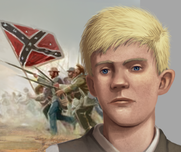 Illustrations by Ian Barstow
Illustrations by Ian Barstow
Jemmy Martin is a farm boy from San Antonio, Texas. He loves the family mules and has no interest in adventure or going to war. But when his brother sells the mules to the Confederate Army, he has no choice but to go along on the expedition to protect them.
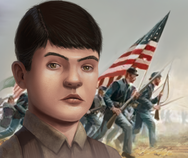
Raul Atencio is the son of a poor peon, but his uncle is one of the most prosperous merchants in town. He wants to become rich and powerful like his uncle, even if it means trading with the American soldiers who are garrisoned at nearby Fort Craig.
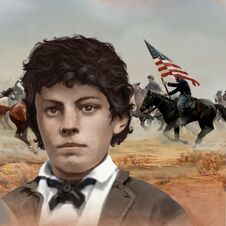
Cian Lochlann's parents brought him to America to escape the Irish Potato Famine when he was only 2. By the time he was 12, he had become an orphan. He escaped the prejudice and poverty of Boston's slums and traveled west to search for gold in the Colorado Rockies, but gave up prospecting to join the Union Army. What Cian really wants is a full belly and a strong man to lead him into an unknown future.
Real People in
REBELS ALONG THE RIO GRANDE
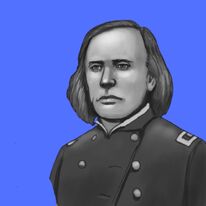 Illustration by Ian Bristow
from Where Duty Calls
Illustration by Ian Bristow
from Where Duty Calls
Christopher "Kit" Carson (December 24, 1809 – May 23, 1868) is perhaps the most famous Indian Scout, mountain man, and frontiersman of all time. Carson left his home in rural Missouri when he was only 16 to become a mountain man and trapper in the rugged Rocky Mountains. By the time of the Civil War, he had added wilderness guide, Indian agent, and U.S. Army officer to his resume. Carson was a legend in his own lifetime, and his exploits, although greatly exaggerated, appeared in dime novels.
Carson was a quiet man, short in stature, and uncomfortable with his own celebrity In Where Duty Calls, he is mending his own clothes when he meets Raul for the first time at Fort Craig. Carson was then leading a division of New Mexico Volunteers.
Carson was a quiet man, short in stature, and uncomfortable with his own celebrity In Where Duty Calls, he is mending his own clothes when he meets Raul for the first time at Fort Craig. Carson was then leading a division of New Mexico Volunteers.
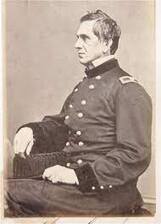
Edward R.S.Canby (November 9, 1817 – April 11, 1873) was a West Point graduate who was in command of New Mexico territory's Fort Defiance when the Civil War broke out. He was appointed colonel of the 19th Infantry on May 14, 1861 and made commander of the Department of New Mexico after the man who had been commander left to join the Confederacy.
More an administrator than a fighter, Canby was a cautious and careful leader. He realized that defending the entire territory from every possible attack would stretch his forces too thinly, so he amassed his troops at Fort Craig, to guard the route up the Rio Grande. He was defeated at the Battle of Valverde, but managed to retain the fort and keep its precious stores of food and arms out of enemy hands. Eventually, this forced the Confederates to abandon their campaign and return to Texas.
Canby made no secret of his distain for the New Mexico Volunteers. His reports blamed them for more cowardice and incompetence than they deserved.
Canby was killed in 1873 while attending peace talks with the Modoc in the Pacific Northwest. He was the only United States general to be killed during the Indian Wars.
More an administrator than a fighter, Canby was a cautious and careful leader. He realized that defending the entire territory from every possible attack would stretch his forces too thinly, so he amassed his troops at Fort Craig, to guard the route up the Rio Grande. He was defeated at the Battle of Valverde, but managed to retain the fort and keep its precious stores of food and arms out of enemy hands. Eventually, this forced the Confederates to abandon their campaign and return to Texas.
Canby made no secret of his distain for the New Mexico Volunteers. His reports blamed them for more cowardice and incompetence than they deserved.
Canby was killed in 1873 while attending peace talks with the Modoc in the Pacific Northwest. He was the only United States general to be killed during the Indian Wars.
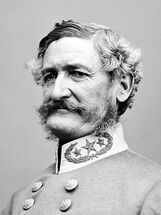
Henry Hopkins Sibley (May 25, 1816 – August 23, 1886) was also a West Point graduate who was serving in New Mexico territory at the outbreak of the Civil War. He resigned his commission on May 13, 1861, the day of his promotion to major in the 1st Dragoons and joined the Confederate Army. Sibley convinced Confederate President Jefferson Davis to put him in command of a brigade of volunteer cavalry in West Texas, which he named the Army of New Mexico. Sibley's intention for the New Mexico Campaign was to capture Fort Union on the Santa Fe Trail and make it a forward base of supply. He would then capture the gold and silver mines of Colorado and the warm-water ports of California. Sibley was accused of alcoholism during his time in New Mexico. Before the war ended, he had been court martialed and censured. After the war, he served as an advisor for the Egyptian Army, but continued to struggle with alcoholism. He died in poverty.
Do you have a copy of Where Duty Calls or The Worst Enemy that hasn't been signed by the author? Let her know and she will send you a signed bookplate that you can put into your copy.
Jennifer Bohnhoff is also happy to send bookmarks and other goodies to readers who've bought her book.
Teachers, contact Ms. Bohnhoff about a free teacher's guide, or a class visit by the author. She is happy to arrange visits either in person or on the internet. See the class visits and presentations page of this website for more information.
Jennifer Bohnhoff is also happy to send bookmarks and other goodies to readers who've bought her book.
Teachers, contact Ms. Bohnhoff about a free teacher's guide, or a class visit by the author. She is happy to arrange visits either in person or on the internet. See the class visits and presentations page of this website for more information.
Places to go to Experience
the Civil War
A lot of time has passed since the Civil War moved through New Mexico. During that time, the Rio Grande has moved its bed, obliterating the old battlefield. Asphalt roads have been laid down where trails used to be. Old buildings have been torn down and replaced by others. All this makes it impossible to see that a soldier might have seen back in the 1860s, but there are still places a interested person can go to see what this period might have been like. Here are a few suggestions. Call ahead to make sure that sites are open.
In Texas
The Military Forces Museum in Austin is housed in a 1918 mess hall and features thousands of war relics and historic photos representing every war from Texas Independence to the present. 512-782-5659
The Institute of Texan Cultures in San Antonio has exhibits about the different cultures that have come together in Texas. They have a small exhibit of Civil War artifacts. 210-458-2300.
In Texas
The Military Forces Museum in Austin is housed in a 1918 mess hall and features thousands of war relics and historic photos representing every war from Texas Independence to the present. 512-782-5659
The Institute of Texan Cultures in San Antonio has exhibits about the different cultures that have come together in Texas. They have a small exhibit of Civil War artifacts. 210-458-2300.
The route that Sibley took to get to New Mexico roughly follows I-90. The Army of New Mexico did not stop at Fort Lancaster, which is located near the town of Sheffield, near I-10, but the ruins of the fort are open and a good example of the kinds of forts that were in Texas at the time. 432-836-4391. Farther west, Fort Davis also has a self guided walking tour. 432-426-3224. Old Fort Bliss is a reconstruction of the adobe fort that existed at the time of the Civil War, and is open for tourists. There is also a military museum at the newer portion of Fort Bliss that has artifacts and exhibits. 915-568-4518 or 915-588-8482.
In New Mexico
It wasn’t there at the time, of course, but when Sibley invaded New Mexico, he largely followed what is now the 1-25 corridor. Here are some places where you can see places mentioned in this story. Call ahead to verify that sites are open.
Old Mesilla was the Confederate western headquarters. Located south of Las Cruces, you can visit the plaza, where the Confederate flag hung. There are Civil War artifacts in the Gadsden Museum, which is located at 1875 W Boutz Rd in Mesilla 575-526-6293.
San Augustin Spring, where Major Isaac Lynde surrendered the garrison of Fort Fillmore to Confederate Lieutenant Colonel John R. Baylor, is just over 14 miles east of Las Cruces on I-70. The springs are not easy to access, but the drive up to San Augustin Pass helps explain why Lynde’s men were struggling in the summer heat, and the view of White Sands and the Tularosa Basin is spectacular.
It wasn’t there at the time, of course, but when Sibley invaded New Mexico, he largely followed what is now the 1-25 corridor. Here are some places where you can see places mentioned in this story. Call ahead to verify that sites are open.
Old Mesilla was the Confederate western headquarters. Located south of Las Cruces, you can visit the plaza, where the Confederate flag hung. There are Civil War artifacts in the Gadsden Museum, which is located at 1875 W Boutz Rd in Mesilla 575-526-6293.
San Augustin Spring, where Major Isaac Lynde surrendered the garrison of Fort Fillmore to Confederate Lieutenant Colonel John R. Baylor, is just over 14 miles east of Las Cruces on I-70. The springs are not easy to access, but the drive up to San Augustin Pass helps explain why Lynde’s men were struggling in the summer heat, and the view of White Sands and the Tularosa Basin is spectacular.
 Ft. Selden
Ft. Selden
The Army didn’t create Fort Seldon until 1865, but the Confederates created Camp Robledo there in 1861 to protect the northern entrance of the Mesilla Valley. The present-day State Monument has displays and self-guided tours that reflect 19th century military life, with a focus on the Buffalo Soldiers and Douglas MacArthur, who lived at the fort when he was a young boy. 575-526-8911.
Only the bottom few feet of some adobe walls, the remnants of the stone jail, and some mounded dirt is all that’s left of Fort Craig, but the National Historic Site offers brochures and self-guided tours. 575-835-0412 From here, the Mesa de la Contadera looms up in the north, making it clear where the battle was fought. The actual battlefield is on private land and is inaccessible except by private tour. The Geronimo Springs Museum, in Truth or Consequences, has hosted these tours in the past. (575) 894-6600.
Only the bottom few feet of some adobe walls, the remnants of the stone jail, and some mounded dirt is all that’s left of Fort Craig, but the National Historic Site offers brochures and self-guided tours. 575-835-0412 From here, the Mesa de la Contadera looms up in the north, making it clear where the battle was fought. The actual battlefield is on private land and is inaccessible except by private tour. The Geronimo Springs Museum, in Truth or Consequences, has hosted these tours in the past. (575) 894-6600.
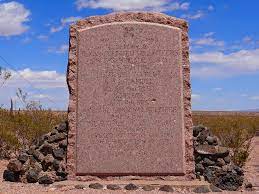
Close to the battlefield, on the west side of the Rio Grande is a Civil War Monument, erected in 1936, that honors the Confederate men and Texas Mounted Volunteers who died at the Battle of Valverde. To see it, take the San Marcial Exit off I-25 (A85) and go east. The monument is right near the entrance to the Armendariz Ranch. San Marcial, a small town built after the Valverde battle which is now a ghost town, is nearby. The town of Valverde, which was already abandoned by the time of the Civil War, was across the river from San Marcial.
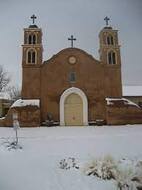
In past years, Socorro sponsored a reenactment of the Battle of Valverde on the weekend closest to the February 21 anniversary of the battle. The town also sponsors several historic walking tours that visit period houses around the plaza. 575-835-0424 The San Miguel church is also on the plaza. Both Pedro Baca and Manuel Armijo are buried there. (575) 835-2891. Some Civil War information can be viewed at the BLM office. (575) 835-0412 in Socorro.

Alfred Petticolas, a Confederate sergeant, sketched this picture of the Confederate flag flying in front of Albuquerque's San Felipe Church when southern troops occupied Albuquerque from March 2 to April 12, 1862. Albuquerque’s Old Town plaza no longer flies the Confederate flag (it was finally taken down in the early 2000s), but two cannons remain near the grandstand. The cannons are replicas of two of the eight cannons which the Confederates buried in a stable behind the church so they could use the guns’ carriages to carry supplies. The cannons were dug up in 1889.
They are also said to have buried some of their dead – casualties of battle or illness – in Albuquerque, but no Confederate graves ever have been found in the Albuquerque area.
They are also said to have buried some of their dead – casualties of battle or illness – in Albuquerque, but no Confederate graves ever have been found in the Albuquerque area.
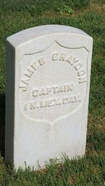
The National Cemetery in Santa Fe was created in 1867 as a result of John P. Slough's efforts to have proper burials for the soldiers killed at Glorieta. The first interments at the cemetery site were the remains of 265 U.S. soldiers taken from the battlefields of Glorieta, Kozlowsky's Ranch, and Fort Marcy. Later, the remains of five Confederate soldiers were removed from the Masonic Cemetery and reinterred in the Santa Fe National Cemetery. The cemetery also has the reinterred remains of soldiers from Fort Craig, which date from the Civil War era and include many Buffalo Soldiers from a later period. Captain James (Paddy) Graydon is buried in plot 9, C474. The cemetery also has a monument honoring the remains of 31 Confederate soldiers who were discovered in a mass grave on the site of the Glorieta battlefield on June 23, 1987 and were reinterred at the Santa Fe National Cemetery on April 25, 1993.
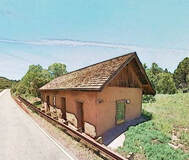
Some of the heaviest fighting during the Battle of Glorieta Pass occured at Pigeon's Ranch. Built around 1857 by Alexander Vallé, a Frenchman known as Pigeon for his dancing style, this house is all that remains of his 23 room establishment that was a popular place to stay along the Santa Fe Trail. From 1926 to1937, when Route 66 passed right beside the house. it became a popular roadside attraction. All that remains is a single building which huddles, forgotten, along NM HW 50 just west of Pecos, New Mexico. The “Oldest Well in the U.S.A.” is still across the road from the ranch house.
Pecos National Park holds what had been Kowzlowski's Ranch, where the Union made its headquarters for the Battle of Glorieta Pass. Their museum has some exhibits about the battle and, in the past, a Union and Confederate camp has been set up on the weekend closest to the date of the battle. A 2.3 mile Civil War Battlefield Trail can be accessed by checking in at the Visitor Center and getting a gate code from a ranger.
Planning to walk the Civil War Battlefield Trail? Here's a guide that supplements the one the forest service can sell you.
Planning to walk the Civil War Battlefield Trail? Here's a guide that supplements the one the forest service can sell you.
